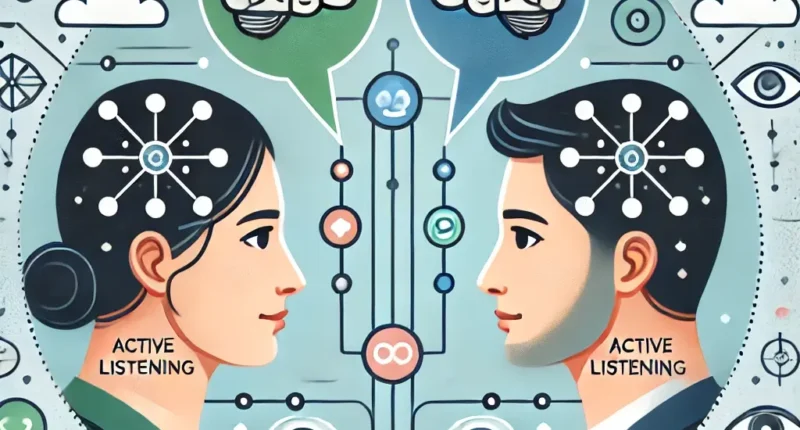Neuro-Linguistic Programming (NLP) is a set of tools and techniques. These are designed to improve communication, influence, and personal development. By understanding and using NLP techniques, we can become more effective communicators. This article explores the essentials of NLP and how it enhances communication.
Table of Contents
- Understanding NLP Basics for Effective Communication Through Neuro-Linguistic Programming (NLP) Techniques
- Keys of Effective Communication Through Neuro-Linguistic Programming (NLP) Techniques
- Using Neuro-Linguistic Programming (NLP) Techniques for Clear Verbal Communication
- The Role of Non-Verbal Cues in Effective Communication Through Neuro-Linguistic Programming (NLP) Techniques
- NLP and Empathy
- NLP for Conflict Resolution
- Practicing NLP Techniques in Daily Life
- Conclusion
Understanding NLP Basics for Effective Communication Through Neuro-Linguistic Programming (NLP) Techniques
NLP combines three main elements: neurology, language, and programming. The “neuro” part relates to how we use our senses to process information. The “linguistic” part involves language and how it shapes our thoughts. Lastly, “programming” refers to the ways we can change patterns in our thinking and behavior. By using NLP techniques, we can better understand ourselves and others.
Keys of Effective Communication Through Neuro-Linguistic Programming (NLP) Techniques
In NLP, several techniques can improve how we connect with people. Let’s explore some essential methods.
1. Rapport Building
Rapport is the foundation of effective communication. When we establish rapport, we create a sense of trust. People are more open to communicating when they feel comfortable.
- Mirroring: One way to build rapport is by mirroring. This involves subtly copying another person’s body language, tone of voice, or gestures. Mirroring can make the other person feel understood and connected.
- Matching: This is similar to mirroring but more subtle. Here, you adapt your behavior to align with the other person’s energy level and communication style.
By practicing these techniques, we build rapport naturally. People will feel more at ease, and communication becomes smoother.
2. Active Listening
Listening actively is crucial for effective communication. It means fully focusing on the speaker, understanding their message, and responding thoughtfully.
- Clarifying: Ask questions to clarify points. For example, say, “Could you explain more about that?”
- Summarizing: Repeat back the main points. Use statements like, “So, what you’re saying is…”
- Empathizing: Show empathy by acknowledging feelings. Say, “That sounds challenging,” to show you understand their emotions.
Active listening builds trust and shows respect. It tells the other person that you value their input.
3. Reframing
Reframing involves looking at a situation from a different perspective. It’s a valuable NLP technique for managing difficult conversations.
- Context Reframing: Change the context of a statement to alter its meaning. For example, if someone says, “I am too detail-oriented,” you could reframe it as, “Being detail-oriented helps you catch important details others might miss.”
- Content Reframing: Shift the focus to a positive aspect of the situation. For instance, if someone feels anxious about a presentation, you might say, “This feeling shows how much you care about doing a great job.”
Reframing helps people see new possibilities. It encourages a positive outlook and can reduce tension.
Using Neuro-Linguistic Programming (NLP) Techniques for Clear Verbal Communication
NLP techniques also improve verbal communication. When we speak with clarity, our message becomes more persuasive.
1. Use of Specific Language
Specific language makes communication clear and understandable.
- Avoiding Vague Terms: Use concrete words rather than general ones. Instead of saying, “We should improve,” say, “We need to increase sales by 10%.”
- Speaking in Positives: Frame statements in a positive way. Instead of “Don’t forget,” try saying, “Remember to…”
When you use specific language, your message is clear. It leaves less room for misunderstanding.
2. The Power of “I” Statements
Using “I” statements can reduce defensiveness in conversations. It makes the speaker take ownership of their feelings.
For instance, say, “I feel concerned when deadlines are missed.” This is more effective than, “You never meet deadlines.” “I” statements focus on the speaker’s feelings and avoid blaming others. This leads to a more constructive conversation.
3. Anchoring
Anchoring is an NLP technique that helps evoke certain emotions or states of mind.
- Creating an Anchor: You can create an anchor by associating a specific gesture or word with a positive feeling. For example, if you touch your thumb and forefinger together whenever you feel confident, that gesture can eventually trigger confidence.
Anchoring can help maintain a calm or positive state in stressful situations. This improves how you communicate under pressure.
The Role of Non-Verbal Cues in Effective Communication Through Neuro-Linguistic Programming (NLP) Techniques
Non-verbal communication makes up a large part of how we interact. NLP focuses on recognizing and using these cues to improve communication.
1. Eye Contact
Eye contact builds trust and shows engagement. However, different cultures have different norms regarding eye contact. It’s essential to be mindful of these differences.
In most Western cultures, maintaining eye contact shows confidence and interest. But, too much eye contact can be intimidating. Find a balance that feels natural and respectful.
2. Body Language Awareness
Body language reveals more than words sometimes. NLP teaches us to observe body language to understand unspoken messages.
- Open Body Language: Keep arms relaxed and maintain an open posture. Closed-off body language, like crossing arms, can signal discomfort or defensiveness.
- Gestures: Use hand gestures to emphasize points. But avoid excessive movement, as it can distract the listener.
By observing and adjusting body language, you communicate a welcoming and attentive presence.
NLP and Empathy
Empathy is at the heart of effective communication. NLP techniques encourage empathy by helping us understand and mirror others’ emotions.
1. Pacing and Leading
Pacing involves matching the other person’s tone, speed, and style. It creates a sense of unity. After establishing pacing, you can “lead” the conversation in a positive direction. For example, if someone is upset, start by matching their tone, then gradually lead them to a calmer state. This process helps others feel heard and often calms tense situations.
2. Perspective-Taking
Perspective-taking means seeing the situation from the other person’s point of view. Ask yourself, “How would I feel if I were in their position?” This simple shift can transform the way you respond. It helps you approach conversations with understanding and kindness.
NLP for Conflict Resolution
NLP techniques are valuable tools for resolving conflicts. They help people communicate openly, listen actively, and find common ground.
1. Use of Meta-Model Questions
The Meta-Model is an NLP tool that uses specific questions to gather information. It helps uncover underlying issues and clarifies vague statements.
For instance, if someone says, “This project is impossible,” you can ask, “What makes it feel impossible?” These questions help break down generalizations and assumptions, leading to a more constructive discussion.
2. Positive Intent Assumption
Assume that everyone has positive intentions. This mindset shift can defuse hostility and create a more cooperative atmosphere. Even if someone criticizes you, respond with empathy. Say, “I understand you have concerns. Let’s discuss how we can resolve this together.”
By assuming positive intent, you encourage openness and reduce defensiveness.
Practicing NLP Techniques in Daily Life
To master NLP, practice is essential. Here are some simple ways to integrate NLP into your everyday interactions.
- Practice Active Listening: Make it a habit to listen without interrupting.
- Experiment with Reframing: Try reframing negative thoughts or comments.
- Use Anchors for Confidence: Practice anchoring to maintain a positive mindset.
Over time, these techniques will become second nature. Communication will feel smoother, and relationships will improve.
Conclusion
So, Now you have a clear understanding about Effective Communication Through Neuro-Linguistic Programming (NLP) Techniques. NLP offers powerful techniques for effective communication. From building rapport to handling conflicts, these methods enhance our ability to connect with others. By practicing NLP daily, we gain valuable skills for personal and professional growth. Ultimately, NLP empowers us to communicate with empathy, clarity, and confidence. In a world where communication is key, NLP techniques provide a path to meaningful and impactful interactions.





